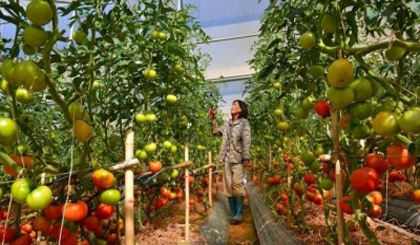New expectations for agriculture
At the preliminary meeting to sum up litchi season in northern Bac Giang province last August, is the news was announced that for first time the Vietnam Institute of Regional Research and Development had successfully used Cells Alive System (CAS) technology – a rapid freeze technology combined with magnetic fields – to help preserve litchi quality for wider transport around the world, even to the most remote markets.
 |
| A high-tech tomato plantation in Da Lat, Lam Dong province. |
To be preserved by freezers at -250oC, CAS technology freezes the water atoms inside the frozen products; the freezing process happens from the inside to the surface of the products, limiting crystallisation of water molecules, inhibiting oxidation, and preventing infection and browning pods, ensuring the quality of litchi at 80-90% compared to the original freshness one after one year of harvesting.
Preservation by CAS will push litchi prices to VND100,000-150,000 per kg; in return, exporters can now sell litchi at much higher prices, from VND250,000 a kg and even higher, depending on the market and the specific time. (In the 2015 lychee season, Vietnamese lychee sold in Australia at AUD21-22 per kg at first, then dropped to AUD15-16/kg, equivalent to about VND250,000 per kg due to competition from Thailand and China). Other types of fruits, such as mangos, dragon fruit, longan, pomelo, and watermelon can use this technology to reduce losses due to damage and low prices.
Vietnam’s agricultural sector generates about 20% of GDP, contributing over US$30 billion to total imports-exports in 2014 and creating livelihoods for millions of farmer households. The delay in using technology, especially storage technology, has caused and will continue to cause financial damage to farmers and declines in agricultural development.
Groundbreaking policies and practices generated during implementation of agricultural development programmes with high-tech applications under Decision No. 1985/QĐ-TTg dated December 17, 2012, are necessary.
Initially, the State should mobilise resources from the national fund for technological innovation and other resources to facilitate operation of the system of agro-forestry, fisheries and industrial promotion.
It is also necessary to intensify investment to improve the capacity of institutes and research centres to promote transfers of science and technology, especially breeding, biotechnology, preservation, processing, and IT, aiming to ensure food safety and quality for high-value added agricultural products.
Localities under the overall planning of agricultural production areas with high-tech applications approved by the Prime Minister in Decision No. 575/ QĐ-TTg dated May 4, 2015 (towards 2020) should actively mobilise resources to ensure adequate funding for construction, while gradually developing and implementing policies to support brand name development and promotion of agricultural products using high-tech production methods.
Breakthroughs in technology, primarily in preserving and ensuring quality and shipping times of products during the post-harvest period, are new dynamics opening up new opportunities for Vietnamese fruits and agriculture.
(Source: nhandan.org.vn)
.
 về đầu trang
về đầu trang






